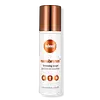What's inside
What's inside
 Key Ingredients
Key Ingredients

 Benefits
Benefits

 Concerns
Concerns

 Ingredients Side-by-side
Ingredients Side-by-side

Butyrospermum Parkii Butter
Skin ConditioningSimmondsia Chinensis Seed Oil
EmollientCaprylic/Capric Triglyceride
MaskingKaolin
AbrasiveSilica
AbrasiveOleic/Linoleic/Linolenic Polyglycerides
EmollientC9-12 Alkane
SolventTribehenin
EmollientVp/Hexadecene Copolymer
Octyldodecanol
EmollientVp/Eicosene Copolymer
Candelilla Cera
EmollientRicinus Communis Seed Oil
MaskingSr-Hydrozoan Polypeptide-1
HumectantTremella Fuciformis Sporocarp Extract
AntioxidantGanoderma Lucidum Stem Extract
Skin ConditioningTocopherol
AntioxidantAscorbyl Palmitate
AntioxidantDisteardimonium Hectorite
StabilisingWater
Skin ConditioningCaprylyl Glycol
EmollientGlyceryl Rosinate
PerfumingSodium Hyaluronate
HumectantCitric Acid
BufferingPotassium Sorbate
PreservativeCI 77891
Cosmetic ColorantIron Oxides
Butyrospermum Parkii Butter, Simmondsia Chinensis Seed Oil, Caprylic/Capric Triglyceride, Kaolin, Silica, Oleic/Linoleic/Linolenic Polyglycerides, C9-12 Alkane, Tribehenin, Vp/Hexadecene Copolymer, Octyldodecanol, Vp/Eicosene Copolymer, Candelilla Cera, Ricinus Communis Seed Oil, Sr-Hydrozoan Polypeptide-1, Tremella Fuciformis Sporocarp Extract, Ganoderma Lucidum Stem Extract, Tocopherol, Ascorbyl Palmitate, Disteardimonium Hectorite, Water, Caprylyl Glycol, Glyceryl Rosinate, Sodium Hyaluronate, Citric Acid, Potassium Sorbate, CI 77891, Iron Oxides
Water
Skin ConditioningGlycerin
HumectantCaprylic/Capric Triglyceride
MaskingButylene Glycol
HumectantMica
Cosmetic ColorantPvp
Emulsion StabilisingSodium Acrylates Copolymer
CI 77491
Cosmetic ColorantCI 77163
Cosmetic ColorantSynthetic Fluorphlogopite
Macrocystis Pyrifera Extract
Skin ConditioningCI 77947
Octyldodecanol
EmollientPhenoxyethanol
PreservativeSqualane
EmollientLecithin
EmollientEthylhexylglycerin
Skin ConditioningCI 77499
Cosmetic ColorantSodium Hyaluronate
HumectantCucumis Sativus Fruit Extract
EmollientTheobroma Cacao Seed Extract
AntioxidantSodium Benzoate
MaskingPisum Sativum Extract
Skin ConditioningPotassium Sorbate
PreservativeWater, Glycerin, Caprylic/Capric Triglyceride, Butylene Glycol, Mica, Pvp, Sodium Acrylates Copolymer, CI 77491, CI 77163, Synthetic Fluorphlogopite, Macrocystis Pyrifera Extract, CI 77947, Octyldodecanol, Phenoxyethanol, Squalane, Lecithin, Ethylhexylglycerin, CI 77499, Sodium Hyaluronate, Cucumis Sativus Fruit Extract, Theobroma Cacao Seed Extract, Sodium Benzoate, Pisum Sativum Extract, Potassium Sorbate
Ingredients Explained
These ingredients are found in both products.
Ingredients higher up in an ingredient list are typically present in a larger amount.
This ingredient is an emollient, solvent, and texture enhancer. It is considered a skin-softener by helping the skin prevent moisture loss.
It helps thicken a product's formula and makes it easier to spread by dissolving clumping compounds.
Caprylic Triglyceride is made by combining glycerin with coconut oil, forming a clear liquid.
While there is an assumption Caprylic Triglyceride can clog pores due to it being derived from coconut oil, there is no research supporting this.
Learn more about Caprylic/Capric TriglycerideOctyldodecanol is a fatty alcohol. It is primarily used to enhance the texture of products.
As an emulsifier, Octyldodecanol helps prevent the oils and waters from separating. It also prevents ingredients from creating foam when shaken.
Octyldodecanol is created by reducing fatty acid to an alcohol.
Due to its high molecular weight, it does not get absorbed into the skin.
Learn more about OctyldodecanolPotassium Sorbate is a preservative used to prevent yeast and mold in products. It is commonly found in both cosmetic and food products.
This ingredient comes from potassium salt derived from sorbic acid. Sorbic acid is a natural antibiotic and effective against fungus.
Both potassium sorbate and sorbic acid can be found in baked goods, cheeses, dried meats, dried fruit, ice cream, pickles, wine, yogurt, and more.
You'll often find this ingredient used with other preservatives.
Learn more about Potassium SorbateSodium Hyaluronate is hyaluronic acid's salt form. It is commonly derived from the sodium salt of hyaluronic acid.
Like hyaluronic acid, it is great at holding water and acts as a humectant. This makes it a great skin hydrating ingredient.
Sodium Hyaluronate is naturally occurring in our bodies and is mostly found in eye fluid and joints.
These are some other common types of Hyaluronic Acid:
Learn more about Sodium HyaluronateWater. It's the most common cosmetic ingredient of all. You'll usually see it at the top of ingredient lists, meaning that it makes up the largest part of the product.
So why is it so popular? Water most often acts as a solvent - this means that it helps dissolve other ingredients into the formulation.
You'll also recognize water as that liquid we all need to stay alive. If you see this, drink a glass of water. Stay hydrated!
Learn more about Water